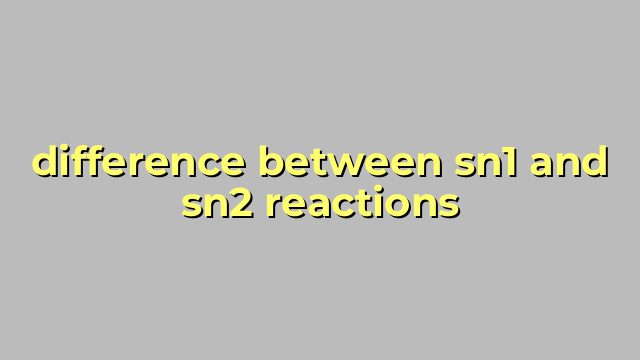The Difference Between SN1 and SN2 Reactions
Organic chemistry is a vast and diverse field that deals with the interactions and reactions of organic compounds. One of the fundamental concepts in organic chemistry is the nucleophilic substitution reaction, which is classified into two types – SN1 and SN2.
Understanding the differences between these two reaction mechanisms is crucial for mastering organic chemistry. In this article, we will explore the key differences between SN1 and SN2 reactions.
SN1 Reactions
SN1 reactions are unimolecular nucleophilic substitution reactions, which means they involve only one reacting species. In SN1 reactions, the rate-determining step involves the formation of a carbocation intermediate.
Here are some key features of SN1 reactions:
– The reaction mechanism has two steps – formation of a carbocation intermediate and then nucleophilic attack.
– The rate of the reaction is determined by the rate of the first step, which involves the heterolysis (breaking) of the C-X bond.
– The reaction exhibits first-order kinetics, meaning that the rate of the reaction is proportional to the concentration of the substrate.
– The reaction occurs more readily with tertiary substrates, as they form more stable carbocation intermediates.
– The stereochemistry of SN1 reactions is not well-defined, as the carbocation intermediate is planar and can undergo racemization.
SN2 Reactions
SN2 reactions are bimolecular nucleophilic substitution reactions, which means they involve two reacting species. In SN2 reactions, the nucleophile attacks the electrophilic carbon atom simultaneously as the leaving group departs, resulting in a single transition state.
Here are some key features of SN2 reactions:
– The reaction mechanism has one step – nucleophilic attack and leaving group departure occur simultaneously.
– The rate-determining step is the formation of the transition state, which involves the nucleophile attacking the substrate while the leaving group departs.
– The reaction exhibits second-order kinetics, meaning that the rate of the reaction is proportional to the concentration of the substrate and the nucleophile.
– The reaction occurs more readily with primary substrates, as they have less steric hindrance.
– The stereochemistry of SN2 reactions is well-defined, as the nucleophile attacks from the back side of the substrate, resulting in an inversion of the stereochemistry.
Conclusion
In summary, SN1 and SN2 reactions are two distinct nucleophilic substitution mechanisms in organic chemistry. SN1 reactions involve the formation of a carbocation intermediate, while SN2 reactions involve a bimolecular attack of the nucleophile on the substrate. Understanding the differences between these two mechanisms is essential for predicting and understanding organic reactions.
Table difference between sn1 and sn2 reactions
Difference between SN1 and SN2 Reactions
| SN1 Reaction | SN2 Reaction |
|---|---|
| Unimolecular reaction | Bimolecular reaction |
| Rate only depends on substrate concentration | Rate depends on both substrate and nucleophile concentration |
| Formation of carbocation intermediate | No formation of carbocation intermediate |
| Proceeds in a polar protic solvent | Proceeds in a polar aprotic solvent |
| Can proceed with both primary and tertiary substrates | Usually proceeds with primary and secondary substrates |
| Products can be a mixture of retention and inversion of configuration | Products are usually a single diastereomer |


